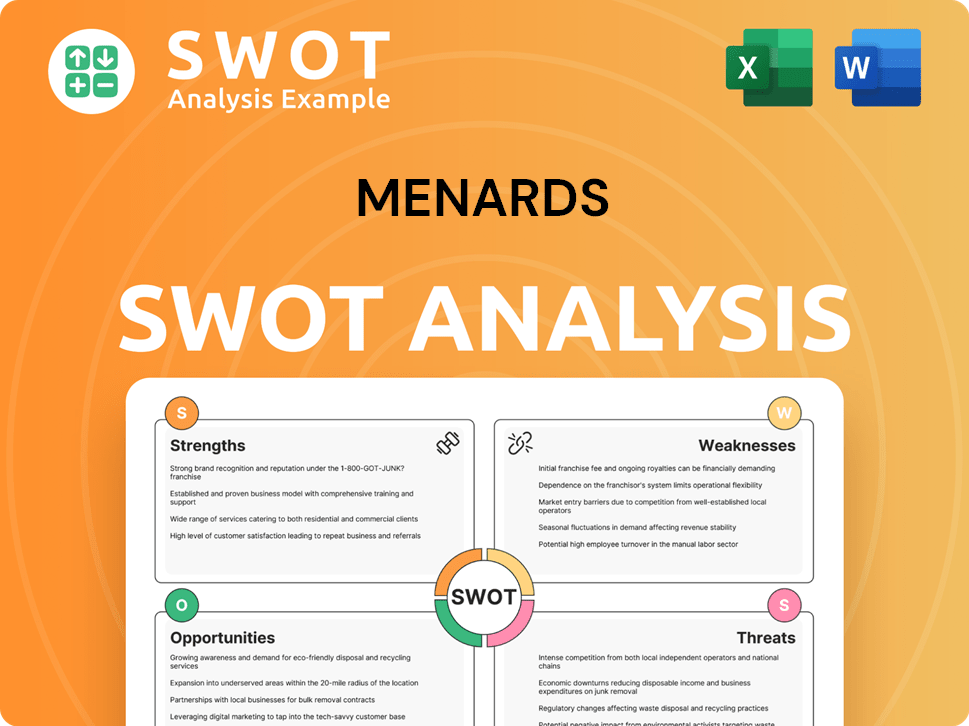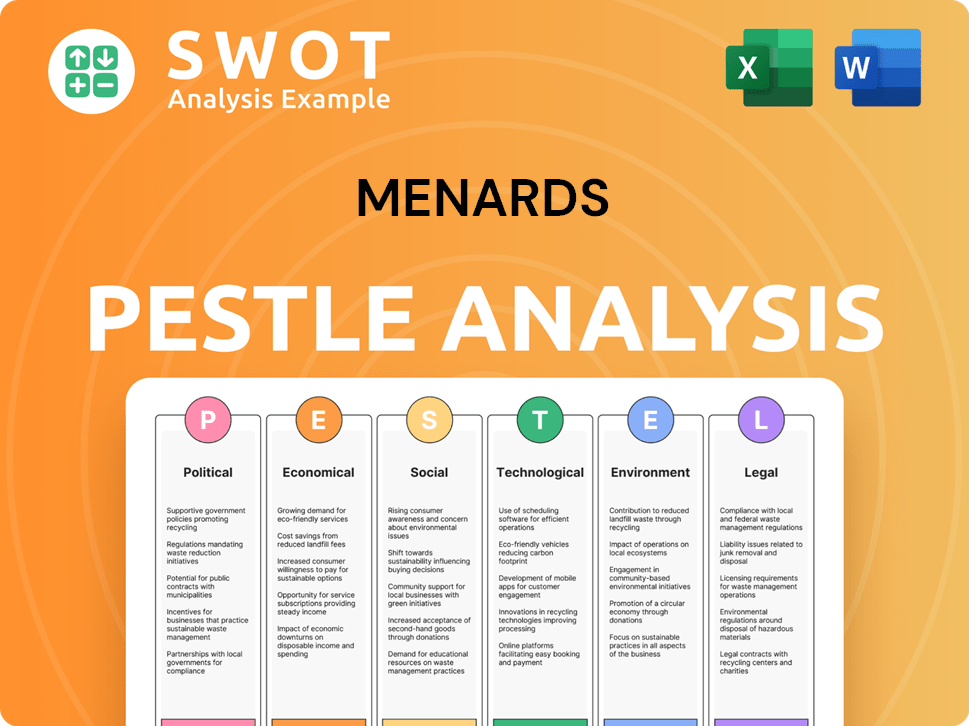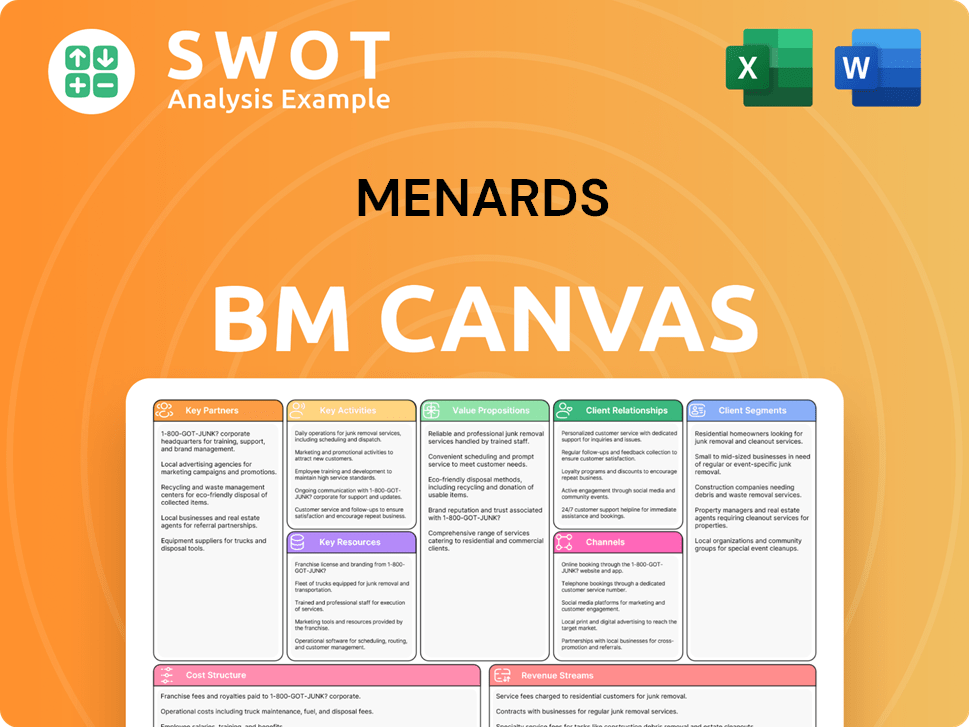Menards Bundle
How Did Menards Become a Home Improvement Powerhouse?
Menards, a privately held giant, has impressively climbed the ranks to become the third-largest home improvement store in the U.S. after Home Depot and Lowe's. But how did this Midwestern favorite achieve such success? The Menards SWOT Analysis reveals the strategic moves that have shaped its remarkable journey. This exploration delves into the company's origin and evolution.

From its inception in 1958 by John Menard Jr., the company quickly transitioned from building post-frame structures to selling building materials. This shift marked the beginning of the Menards company we know today. The company's focus on providing affordable options and a vast product selection has been critical to its expansion across the Midwest. Understanding the brief history of Menards provides valuable insights into its business model and its ongoing impact on the home improvement industry.
What is the Menards Founding Story?
The story of the Menards company begins with John Menard Jr.'s entrepreneurial drive and his ability to spot a market need. In the late 1950s, he started a business building post-frame buildings to fund his education, recognizing the rising demand for affordable agricultural structures.
This early venture set the stage for the official founding of Menards. The business model evolved from construction to include selling building materials directly to customers. This expansion led to the opening of the first retail location, marking a significant step in the company's history.
John Menard Jr.'s upbringing, influenced by his parents' values of frugality and practicality, shaped the company's approach. This focus on cost-effectiveness and customer accessibility helped Menards stand out. The company's growth was funded through its own cash flow, reflecting a commitment to financial discipline.
John Menard Jr. founded Menards in 1960, after starting a construction business in 1958. The company's initial focus was on building post-frame structures for agricultural purposes.
- In 1960, Menards was officially founded by John Menard Jr.
- The first retail location, called Menard Cashway Lumber, opened in Eau Claire, Wisconsin, in 1964.
- John Menard Jr.'s background, shaped by his parents' values, influenced the company's ethos.
- The company's growth was financed through its own cash flow, demonstrating a commitment to financial discipline.
The initial focus of Menards was on building post-frame buildings. In 1958, John Menard Jr., while attending the University of Wisconsin–Eau Claire, began constructing these buildings to finance his education. He recognized a need for affordable agricultural buildings, spurred by the mechanization of the farm industry. By the end of 1959, the demand for his pole buildings required hiring more crews and buying more equipment, including a 1946 Chevrolet truck and an old Ford tractor. The company was officially founded in 1960, and in 1962, John Menard Jr. incorporated the business after graduating from college, becoming its president and major stockholder.
The business model evolved to include selling lumber and building materials on a cash-and-carry basis. This shift led to the opening of the first retail location in Eau Claire in 1964, initially called Menard Cashway Lumber. John Menard Jr.'s background, with influences from his teacher and dairy farmer parents, instilled values of frugality and common sense, which shaped the company's ethos. He differentiated his stores from traditional lumberyards with wide aisles, tile floors, and accessible shelves. The company's expansion was funded through its own cash flow, showcasing a commitment to cost containment.
The company's initial focus was on providing low-cost buildings. The business model included selling lumber and building materials directly to customers. This approach led to the opening of the first retail store. The company's growth was funded internally, reflecting a commitment to financial prudence. You can learn more about the company's core values and mission by reading about the Mission, Vision & Core Values of Menards.
Menards SWOT Analysis
- Complete SWOT Breakdown
- Fully Customizable
- Editable in Excel & Word
- Professional Formatting
- Investor-Ready Format

What Drove the Early Growth of Menards?
The early growth and expansion of the Menards company, a key part of its history, was marked by strategic diversification and rapid expansion across the Midwest. This period saw the company evolve from its lumber store beginnings to a major player in the home improvement industry. This expansion included both geographic growth and the addition of manufacturing capabilities to support its retail operations.
After the establishment of Menard Cashway Lumber in 1964, the company moved into manufacturing. A truss plant opened in the late 1960s, which developed into the Menard Building Division. This division produced various construction materials. This strategic move helped Menards control its supply chain and offer competitive pricing.
During the 1970s and 1980s, Menards significantly increased its retail footprint. New Menards locations opened in several Midwestern states, including Iowa, Minnesota, North Dakota, and South Dakota. By 1986, Menards had risen to 15th among home improvement chains.
The early 1990s marked another period of aggressive Menards expansion. The company entered Nebraska in 1990, the Chicago area in 1991, and Indiana and Michigan in 1992. Large warehouse/distribution centers and manufacturing plants supported this growth. By the end of 1993, Menards operated 88 stores and generated $1.7 billion in revenues.
In 1994, Menards sold its Menard Building Division to focus solely on retail operations. By the end of 1995, the company had 115 outlets and sales of $2.7 billion. Menards' expansion in the Chicago area significantly impacted competitors. The company's strategy included competitive pricing and a mass merchandiser store format.
Menards PESTLE Analysis
- Covers All 6 PESTLE Categories
- No Research Needed – Save Hours of Work
- Built by Experts, Trusted by Consultants
- Instant Download, Ready to Use
- 100% Editable, Fully Customizable

What are the key Milestones in Menards history?
The Menards company has a rich history marked by significant milestones, continuous innovation, and various challenges. The Menards story began with its founder, John Menard, and has since grown into a major player in the home improvement industry. This growth reflects its strategic business decisions and adaptation to market changes.
| Year | Milestone |
|---|---|
| Early Years | John Menard founded the company, laying the foundation for its future growth. |
| 2000 | Reached the milestone of having 150 Menards store locations. |
| 2007 | Introduced groceries in larger Menards store locations, diversifying product lines. |
| 2007 | Opened large distribution centers in Holiday City, Ohio, and Shelby, Iowa, expanding its distribution network. |
| 2024 | Ranked first in J.D. Power's survey among national home improvement retail stores. |
| 2024 | Led in overall brand satisfaction, cleanliness, merchandise variety, and value for money in a study by Market Force Information. |
A key innovation for the Menards company was its vertically integrated business model, operating its own manufacturing facilities to maintain low prices. This commitment to affordability is reflected in its long-standing slogan, 'Save Big Money at Menards.'
Menards operates its own manufacturing facilities, a rarity among retailers, enabling it to control costs and offer competitive pricing. This model allows for greater control over the supply chain and product quality.
The introduction of groceries in larger stores broadened the appeal of Menards, attracting a wider customer base. This diversification helped Menards compete more effectively in the retail market.
The establishment of large distribution centers in strategic locations enhanced the company's logistical capabilities. This expansion improved efficiency in delivering products to Menards store locations.
Menards consistently ranks high in customer satisfaction surveys, reflecting its focus on providing a positive shopping experience. This customer-centric approach helps build brand loyalty.
Menards is recognized for offering good value, with a focus on competitive pricing and promotions. This focus on value drives customer traffic and sales.
In 2024, Menards led in overall brand satisfaction, cleanliness, merchandise variety, and value for money, capturing 77% of customers' next ten purchases. This leadership position highlights its strong market presence.
Despite its successes, the Menards company has faced several challenges. These include regulatory violations and legal issues, such as lawsuits from former employees and claims of gender discrimination. The home improvement industry experienced a slowdown in discretionary spending in 2024, impacting retailers like Menards.
The company has faced regulatory challenges, including violations related to pollution and waste disposal. These issues can lead to fines, legal battles, and reputational damage.
Menards has dealt with lawsuits and claims, including those related to employment practices. These legal battles can be costly and time-consuming.
During the pandemic, Menards received complaints regarding price gouging and store entry restrictions. These issues highlighted the challenges of maintaining a positive reputation and adhering to regulations during crises.
In 2024, the home improvement industry faced a slowdown in discretionary spending due to rising interest rates and economic uncertainties. This downturn impacted Menards and other retailers.
Menards and other regional players have had to pivot their messaging to focus on essential repairs and budget-conscious solutions. These shifts are crucial for adapting to changing market conditions.
The ability to adapt to economic downturns and changing consumer behaviors is critical for the long-term success of the Menards company. This adaptability is key to navigating challenges.
To understand more about the ownership structure and financial aspects of Menards, you can read more here: Owners & Shareholders of Menards.
Menards Business Model Canvas
- Complete 9-Block Business Model Canvas
- Effortlessly Communicate Your Business Strategy
- Investor-Ready BMC Format
- 100% Editable and Customizable
- Clear and Structured Layout

What is the Timeline of Key Events for Menards?
The Menards history began with John Menard Jr. in 1958, evolving from post-frame building construction to a major player in the home improvement industry. The company has seen continuous expansion and strategic adjustments, growing from its Eau Claire, Wisconsin, roots to a vast network of stores across multiple states. This journey reflects a commitment to value and customer satisfaction, which has propelled the company's growth over the years.
| Year | Key Event |
|---|---|
| 1958 | John Menard Jr. starts building post-frame buildings to finance his college education. |
| 1960 | The company is founded by John Menard Jr. |
| 1962 | John Menard Jr. incorporates his business in Eau Claire, Wisconsin. |
| 1964 | The first Menard Cashway Lumber retail location opens in Eau Claire. |
| Late 1960s | Menards opens a truss plant, forming the Menard Building Division. |
| 1970s-1980s | Expansion into several Midwest states, including Iowa, Minnesota, North Dakota, and South Dakota. |
| 1986 | Menards ranks 15th among top home improvement chains. |
| 1990-1992 | Expansion into Nebraska (1990), Illinois (1991), and Indiana and Michigan (1992). |
| 1994 | Menards sells its Building Division after 36 years. |
| 1996 | Ranked 44th on Forbes' list of largest private U.S. companies. |
| 2000 | Opens its 150th store. |
| Early to Mid-2000s | Expansion into Ohio. |
| 2007 | Groceries are introduced in larger stores; new distribution centers open in Ohio and Iowa. |
| 2008-2012 | Expansion into Missouri, Wyoming, Kansas, and Kentucky. |
| 2020 | Expands into West Virginia with three locations. |
| 2021 | Ranks 26th on Forbes' list of 'America's Largest Private Companies.' |
| 2022 | Ranks 34th on the National Retail Federation's '100 Top Retailers' and announces venture into Pennsylvania. |
| 2024 | Ranks first in J.D. Power's customer satisfaction survey among national home improvement retail stores. |
| 2024 | Estimated annual revenue of $10 billion. |
| 2024 | Operates 341 stores and 4 distribution centers. |
The home improvement industry faces a cautious consumer mindset in 2025 due to rising interest rates. This shift leads to a focus on essential repairs and budget-conscious solutions rather than large-scale projects.
Despite the cautious outlook, the U.S. Home and Garden industry experienced its best quarter since Q3 2022 in Q4 2024, showing moderate optimism for 2025. Revenue for home improvement stores is expected to grow at a CAGR of 1.7% to $292.8 billion through the end of 2025, including a 1.9% growth in 2025 alone.
Menards, known for affordability and customer satisfaction, is well-positioned to adapt to these trends. The company's existing strengths in product diversity, competitive pricing, and efficient distribution will be key to its strategy.
The company continues to expand its footprint, with plans for more locations in West Virginia and Pennsylvania. The company's enduring commitment to providing value, a principle rooted in John Menard Jr.'s founding vision, will remain central to its future outlook.
Menards Porter's Five Forces Analysis
- Covers All 5 Competitive Forces in Detail
- Structured for Consultants, Students, and Founders
- 100% Editable in Microsoft Word & Excel
- Instant Digital Download – Use Immediately
- Compatible with Mac & PC – Fully Unlocked

Related Blogs
- What is Competitive Landscape of Menards Company?
- What is Growth Strategy and Future Prospects of Menards Company?
- How Does Menards Company Work?
- What is Sales and Marketing Strategy of Menards Company?
- What is Brief History of Menards Company?
- Who Owns Menards Company?
- What is Customer Demographics and Target Market of Menards Company?
Disclaimer
All information, articles, and product details provided on this website are for general informational and educational purposes only. We do not claim any ownership over, nor do we intend to infringe upon, any trademarks, copyrights, logos, brand names, or other intellectual property mentioned or depicted on this site. Such intellectual property remains the property of its respective owners, and any references here are made solely for identification or informational purposes, without implying any affiliation, endorsement, or partnership.
We make no representations or warranties, express or implied, regarding the accuracy, completeness, or suitability of any content or products presented. Nothing on this website should be construed as legal, tax, investment, financial, medical, or other professional advice. In addition, no part of this site—including articles or product references—constitutes a solicitation, recommendation, endorsement, advertisement, or offer to buy or sell any securities, franchises, or other financial instruments, particularly in jurisdictions where such activity would be unlawful.
All content is of a general nature and may not address the specific circumstances of any individual or entity. It is not a substitute for professional advice or services. Any actions you take based on the information provided here are strictly at your own risk. You accept full responsibility for any decisions or outcomes arising from your use of this website and agree to release us from any liability in connection with your use of, or reliance upon, the content or products found herein.